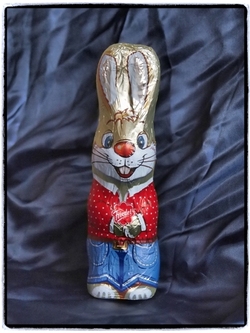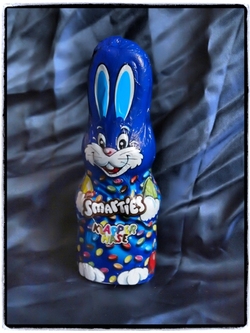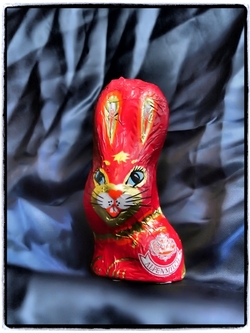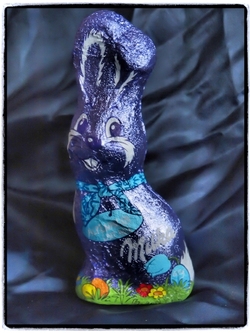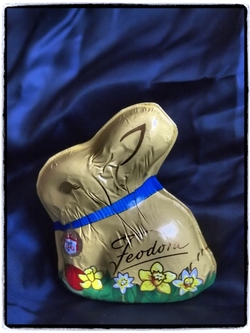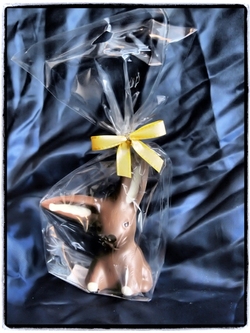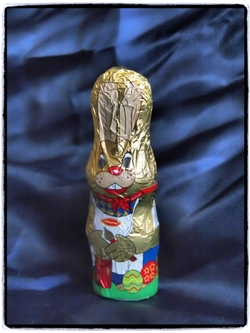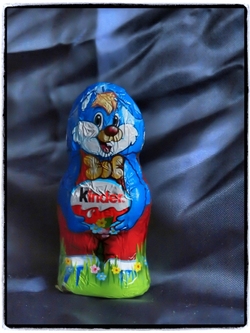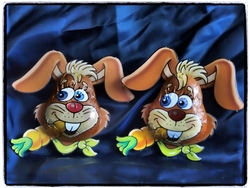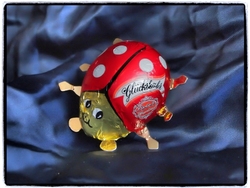What good is living in Germany amid all this great chocolate without learning a bit more? It's all in the name of cultural research, right?
So we gathered up chocolate bunnies from the major German chocolate producers, as well as a few Belgian and Swiss producers, to see what was out there. And, as with the beer tasting, we learned quite a bit about the history of the local chocolatiers!
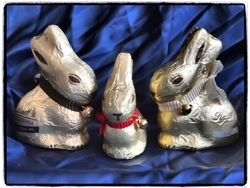 Lindt Goldhasen (Switzerland)Lindt
Lindt Goldhasen (Switzerland)Lindt
We begin, of course, with the famous Lindt Goldhasen. Lindt & Sprüngli AG is widely available, good quality Swiss chocolate and has stores throughout Europe and the US. It began in 1845, with a history quite common for many European companies. A father and son began the Sprüngli business by opening a café in Zurich making the new style bars of chocolate that were becoming popular in Italy. Upon the son's retirement, he split the business between his two sons, giving one the two stores and the other the chocolate factory. The store continues today as a Swiss institution (and of course expanded into other Swiss cities) and is the famous Confiserie Sprüngli known for the past 50 years for it's heavenly "Luxemburgerli" macarons.
The other son took his chocolate factory public to finance expansion and bought Rodolphe Lindt's factory and its secrets of making superior soft chocolate, giving birth to the Lindt & Sprüngli chocolate company. Almost 15 years ago, Lindt bought chocolatier Ghirardelli and has transformed it into an international brand. Sadly, it isn't available here...I love the dark chocolate bars with mint filling!
Lindt is best known for its Goldhasen and Lindor Truffels, both of which were invented in the 1950s. Unfortunately for Herr J and I, they don't make the peanut butter ones in Europe. But if you love peanut butter and chocolate, I highly encourage you to try one - they're the orange ones. The Lindor balls began as seasonal Christmas chocolates but were so popular they now are available in many flavors year round. The Goldhasen still are only for Easter. For more history, check out Lindt's Secrets of Chocolate Book.
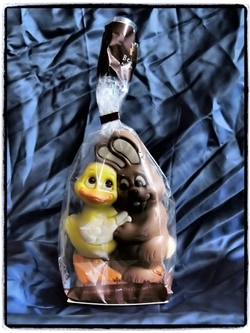 Belfine chocolate bunny and chick (Belgium)Belfine
Belfine chocolate bunny and chick (Belgium)Belfine
Next up, we have the super adorable bunny and chick from Belgian chocolatier Belfine. In addition to being really great chocolate, they had some of the cutest Easter figures of rabbits, chicks, and lambs, also utilizing colored chocolates. They specialize in cuteness, and looking at both the selection in the store and on their website, I say they achieve this goal well. The Christmas penguin metronomes on their website header are over the top in cuteness.
None of this is a surprise, once we learn that Belfine is owned by ChocDecor, a company blending technology and Belgian chocolate-making tradition to sculpt chocolate into beautiful figures. Both are fairly new entrants into the chocolate market, founded only in 1995. I appreciate their mission statement of "Make People Happy" - it just seems appropriate for a chocolate company!
Friedel
For the past 10 years, Friedel has been part of the Rübezahl Schokoladen company, which also makes the tasty Sun Rice snacks and these odd chocolate-gummibear bars. This is their brand that covers the Christmas and Easter chocolates. Though Rübezahl is another typical mid-sized family company formed after the war (based near Stuttgart), Friedel comes from Wernigerode, home of the Hasseröder pils that went far in our beer tournament.
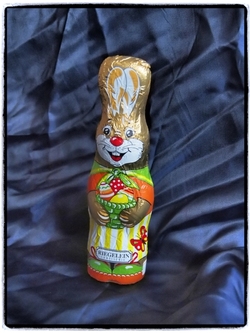 Riegelein chocolate rabbitRiegelein Confiserie
Riegelein chocolate rabbitRiegelein Confiserie
This company prides itself on tempting you with "creative chocolate" and a variety of seasonal, special-occasion products. Based near Nuremberg since 1953, they do export worldwide, but sell 70% of their product domestically so they might not be familiar outside the German-speaking area. The company remains a family-held enterprise, focusing on chocolate figurines (over 750 varieties are available, largely in their 33% cocoa milk chocolate blend). They do, however, make some gummi and fondant products for a bit of variety, and these awesome bittersweet chocolate cups you can easily fill for impressive desserts. The fondant fried eggs in our Easter basket are Riegelein. While adhering to the German values of quality ingredients and workmanship, they also like to reflect through their figures the changing times.
Smarties
Though it's not quite fine or German chocolate, we had to include one of the many candy chocolate bunnies you see in stores here. Kit Kat, After Eight, and others make these, filled with some candies or Kit Kat bits. Not to be confused with American Smarties (the sweet/tart rolls), these are Nestlé's version of M&Ms. So, here we try not only Nestlé rabbit, but also mini-Smarties. They're a bit more brightly colored than M&Ms, have thicker shells, and come in tubes rather than bags. In general, they're pretty good (especially in a McFlurry), as they should be having been in production since the 1880s (the were originally called "Chocolate Beans" in England)! Most Smarties are produced in Germany now (except the Canadian ones made locally), and interestingly only use natural dyes.
Paul Reber is best known for their Mozart truffels (the “Genuine Reber Mozart Kugeln®“), which feature a hazelnut nougat center, surrounded by pistacchio marzipan, and dipped in chocolate. For Easter, they feature a wide variety of filled chocolate eggs, as well as this cute milk chocolate rabbit wrapped in their signature red, white, and gold packaging. Reber has been making chocolate since 1865, in Bad Reichenhall, a spa/vacation area in the Bayerisch Gmain. It looks to be a beautiful old town set in the mountains, just on the border with Austria. Similar to Salzburg, they played a major part in the old salt trade, dating back before the Romans. Looks like it might be a great option for a weekend trip, of course with a stop at the Reber Cafe!
Milka
One of the most recognizeable German chocolates, Milka grew out of a Swissman's chocolate company, becoming the German Milka in 1901. Though they'd always had the Milka cow on the label, it was only 40 years ago that the cow became the famous purple Milka cow. (It's a Simmental cow, by the way.) Milka makes only milk chocolate, mostly in Lörrach, and with a WIDE variety of fruits, nuts, and candies in it. I don't know why it isn't sold outside of Europe, but you can order it from German Deli in the US. Milka strives to maintain its Alpine connections, including sponsoring a women's downhill skiing team and a booth at the World Cup. But I'm most happy about their new product line, Milka & Daim - Daim basically is the Swedish version of a Skor or Heath bar, so imagine bits of buttery toffee in Milka products. Yum!
Feodora
Feodora was established in 1910 in Tangermünde - a middle ages town around 2 hours west of Berlin, at the intersection of the Elbe and Tanger rivers. When the factory was expropriated and dismantled after the Second World War, they reestablished production in Bremen and have remained there since. Named after Princess Feodora (sister of the last empress of Germany), the company is known for its finely decorated pralines (pralines being chocolates with some kind of filling, not the equally good American-style buttery nut pralines). But of course, everyone needs to make a chocolate bunny - Feodora's maintains its traditional packaging with the coat of arms of Schleswig-Holstein hanging on the bunny's collar.
Heilemann
Like Feodora, Heilemann is best known for its truffles and pralines. I love them for making the most adorable chocolate bunny I've seen. I've had one the past 2 Easters - though he looks too cute to eat, you need to do it...the chocolate is great! Heilemann hails from the Allgäu Region, in the foothills of the Alps. Interestingly, they became a subsidiary of Freidel for about 20 years (after the founder Heilemann's death), but today again are an independent chocolatier.
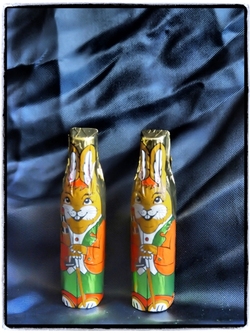 Asbach liqueur praline rabbits
Asbach liqueur praline rabbits
Asbach
A bit unusual for the usual Easter bunny, but Asbach only makes one kind of chocolate....the kind filled with Asbach Uralt ("Asbach Ancient"). Asbach basically is German cognac, except that they had to stop calling it cognac after the Treaty of Versailles declared that only French products could be called cognac. Hugo Asbach displayed great marketing savvy by creating the Asbach pralines in 1924 - it was aimed at women (as female public drinking was looked down upon), but also became quite popular among men. It has a very thin sugar crust separating the chocolate from the brandy, also giving it a bit of sweetness. The Asbach pralines are popular year-round, but for Easter are wrapped in bunny foil rather than the foil printed with a picture of a bottle.
Schwermer
One of the oldest chocolatiers here, Schwermer began as a confisserie/café in Königsberg, East Prussia, which today is Kaliningrad, Russia. Not suprisinlgy, Schwermer had to relocate after the Second World War, and chose Bad Wörishofen (also in the Allgäu region) as their new location. Among their claims to fame, Schwermer pralines have been to the MIR space station and onboard the Columbia space shuttle (taken by German astronauts, of course!). More meaningful to me...if you have a craving for baumkuchen, Schwermer makes these year round, not just at Christmas!
Kinder
This guy is basically a Kinder Egg, with no suprise inside. It's the same soft, two-layered chocolate - milk chocolate outside, a white milk layer inside. We were actually disappointed that there was no surprise inside. I really like most Kinder products, but it's their fillings and their toys that are the reason, not as much the chocolate on its own. We included it, because it was one of the classic German chocolate brands, but I'd recommend sticking with the other chocolate brands if you want a plain Easter bunny. Nothing against Kinder, its just not their strength when it's compared to all of these rich chocolates. If there were a Kinder Hippo type or Bueno or some of the refrigerated treats....then I'd definitely be raving about it. Or if there were a cool toy inside.
Storz
While Storz is not a luxury chocolate, it's still a good quality and tasting one. The family business began in 1884 in Tuttlingen (Baden Württemberg) and weathered the wars and crises by finally focusing on "Ideas moulded into chocolate." Basically their niche is to make small foil wrapped chocolates in cute and creative wrapping (using not only printed foils but also cardboard cutouts). They also make these to order for companies, hotels, and conventions, so have really stuck with what works. They had a huge variety of fun Easter shapes, but I picked these slightly crazy looking bunnies.
Reber Glückskäfer
Reber again...At first I couldn't find a Reber bunny, so I got one of their lucky ladybugs. Too cute not to include!
Sadly, I couldn't find any Ritter Easter bunnies, but we'll have to save Ritter for another day!
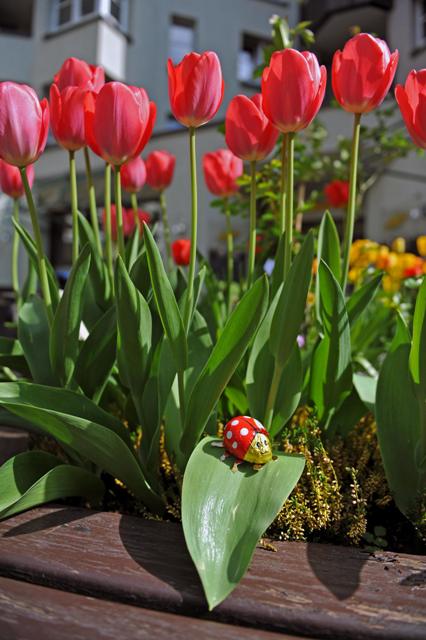 Glückskäfer on Easter holiday
Glückskäfer on Easter holiday
